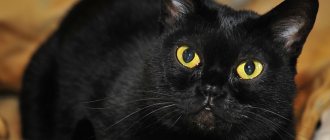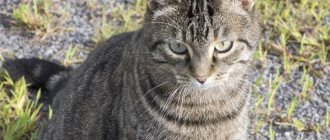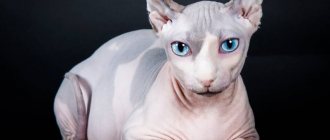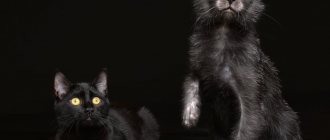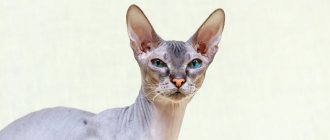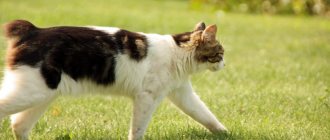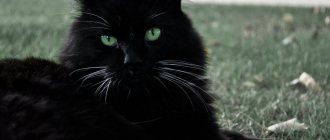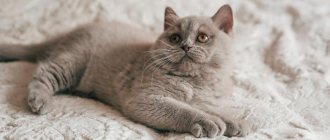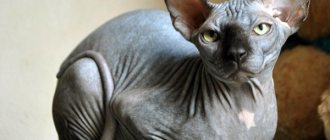Some people adore sphinxes, others consider them unsightly, however, there are no people in the world who are indifferent to these unearthly creatures. Because of their unusual appearance, particularly their large ears, expressive eyes and lack of fur, Sphynx cats are affectionately called “moon cats” and “aliens.”
| Breed name | Canadian Sphynx |
| Path of occurrence | Spontaneous mutation |
| Country of origin | Canada |
| Coat | Hairless, flock, velor, brush |
| Lifespan | 12 – 16 years old |
| Kitten price | 10 – 25 thousand rubles |
Origin story
Mentions of hairless cats can be found in the chronicles of different nations. This is due to the fact that a hairless kitten could appear from completely ordinary parents. Initially, such unusual kittens were considered discarded.
Reference! The appearance of the Sphinx is considered a natural mutation.
Officially, the birth of the breed is considered to be 1966. Then in Toronto (Canada) a domestic cat gave birth to a hairless kitten. The cat's owner gave the baby the name Prune (Prune). At the same time, sphinxes began to appear in nurseries.
Initially, the kittens were called “Canadian Hairless Cat,” but not everyone liked such a long and ordinary name. Fans of hairless cats were looking for a euphonious name for the breed and drew parallels with the oldest surviving sculpture - the Egyptian Great Sphinx.
Cost of kittens
For those planning to purchase a Canadian Sphynx, you should consider the following features:
- Specifics of the content.
- The specificity of the species - not everyone likes it. It is worth considering that Sphynx kittens may look cuter than adult representatives of this breed.
The price for kittens reaches 10,000 rubles.
Description of the breed
A distinctive feature of the breed is hairlessness, but it is not the only one.
Sphynx standard
A purebred Sphynx must meet the following standards:
- Body: warm and soft to the touch, like a soft peach. Average build with unexpectedly high weight; the belly is rounded. Sphinxes are characterized by sexual dimorphism, i.e. The difference between females and males is in size and weight - females are much smaller than males. Thus, the weight of a male reaches 5 kg, of a female – up to 3.5 kg.
- Limbs: proportional, muscular. The hind legs are longer than the front legs. The front legs are set wide due to the large chest (“bulldog” style). The pads of the toes are thick and make the paw look like a baby's fist.
- Head: the shape resembles a modified wedge, the length of the head is slightly greater than the width, pronounced cheekbones. The skull is rounded, the nose is straight with a pronounced “hollow” where the forehead meets the nose.
- Eyes: large, round, lemon-shaped (wide in the middle and tapering towards the edges); the distance between the eyes is slightly larger than the size of the eye. Any eye color.
- Ears: very large, open, erect. Set wide apart, without brushes.
- Wool: a small light fluff on the skin is possible - the skin of a sphinx is often compared to the skin of a child; a tuft of hair at the tip of the tail is also acceptable. The length of hair on the body is divided into the following types:
- naked (homozygous) - hair and whiskers are completely absent, the body is covered with numerous folds of skin. Rarely born. Cats feel rubbery and sticky to the touch. It is difficult to stroke such a sphinx, so it is as if they are gently pinching the skin.
- flock - thin microhairs up to 0.1 cm; as sphinxes grow older, they can undress and become naked. The flock feels like velvet to the touch; such a cat can be stroked with your hand without difficulty.
- velor - wool 0.2 - 0.4 cm long. Wool may not be present on all parts of the body.
- brush (velor) - hair length up to 0.5 cm. The coat is straight or curled, like a Rex, and feels hard to the touch.
Hollowborn
Flock
Velours
Brush
Colors
The color of sphinxes without hair is determined by pigmentation on the skin. The color of the naked-born Sphynx appears 2-3 hours after birth.
Types of colors of Canadian Sphynxes:
- Solid: the predominance of one color in pigmentation. The nose is combined with the color, the paw pads are either the color of the pigmentation or a pinkish tint. Possible colors:
- white;
- cream;
- lilac;
- blue;
- faun;
- cinnamon;
- red (red);
- chocolate;
- black.
- Tortoiseshell (totrie): Characteristic only for females. It is rarely found in cats and is regarded as a deviation - such males are most often infertile. Pigmentation consists of two colors: in the classic version – black and red; in clarified - blue and cream. Proportions and variations may vary. Possible options:
- blue turtle;
- black;
- lilac;
- chocolate cake;
- tortoiseshell cinnamon;
- tortoiseshell faun.
- Tabby color (tabby): dark spots on the back, tail and limbs. The nose and paw pads are either pigmented or pinkish in color (typical of light colors). Tabby color types:
- spotted – pigmentation in the form of spots;
- marbled - spots on the body in the form of patterns similar to stripes on marble;
- tiger/mackerel – spots in the form of horizontal stripes.
- Bicolor: primary color (solid, tortoiseshell, tabby) combined with white. The painted part has clear boundaries from white. One ear should be painted. The nose and paw pads match the base color.
- Color-point: The color characteristic of Siamese cats is a light body with darker tips of the ears, nose, paws and tail. Characteristic eye color is sky blue. The paw pads and nose match the color of the point. Depending on the “darkened” color, color options can be:
- seal point;
- chocolate point;
- blue point;
- lilac point;
- cream point.
Breed standards and characteristics
| Head | It has a wedge shape with prominent cheekbones and a straight nose. There are small folds of skin on the top of the head. The nose is straight. The neck is of medium length, muscular. Despite the fact that their ancestors had mustaches, the sphinxes did not inherit them. |
| Ears | Big as bat wings. Vertically standing huge prickly pointed or rounded ones. |
| Eyes | Important characteristics are the lemon-shaped eyes, narrow at the edges. Eye color may vary. Canadians may have heterochromia in one or both eyes. |
| Body | Medium size, muscular, hot to the touch, with a wide chest, sometimes barrel-shaped. |
| Weight | The weight of an adult cat is 3.5–5 kg. Even the largest individuals do not weigh more than 5–6 kg. |
| Limbs | The legs are slender, strong, muscular, of medium length, proportional to the body. The hind limbs are slightly longer than the forelimbs. The joints are pronounced. |
| Tail | Flexible and long, tapering at the end. |
| Wool | The length of the wool does not exceed 1–2 mm. The skin is smooth to the touch, thick and wrinkled. |
Interesting! Sphynx cats cannot be described without mentioning the incredible number of folds of skin they have. The more folds, the higher the value. They have so much bare skin that even if the animal were stretched to its full length, it would still have folds.
What else you should know about the Sphinx:
- An adult sphinx is covered with fine down, reminiscent of a peach to the touch.
- The Sphynx's ears are 2-3 inches (5-7 cm) high.
- The friendly Sphynx is easy to communicate with and loves to make new acquaintances. It can become not only an excellent exhibition specimen, but also a friend and family companion.
- The Sphynx is a strong breed, with medium bones and a muscular and athletic build.
- Since the breed has no fur or hair, water treatments should be carried out frequently.
Photos of colors
Blue
Cream
White
Black
Red
Bicolor
Tortoiseshell
Tabby
Differences between the Canadian, Don and St. Petersburg sphinxes
The Canadian Sphynx became the first breed to officially recognize hairlessness as a standard. The Don Sphynx and Peterbald are related breeds whose homeland is Russia. The St. Petersburg Sphynx appeared as a result of crossing the Donchak and the Oriental cat.
Visual differences in the structure of the muzzle of these three breeds are clearly visible in the photo below.
| Petersburg Sphinx | Canadian Sphynx | Don Sphynx |
| Elongated, elegant body with well-developed muscles and a long neck. Long straight tail, slightly tapering to the tip. | Average build with a round belly. Wide chest. Large paw pads Thin whip-shaped tail | Strong medium to large bone, prominent belly Straight, medium length tail |
| The shape of the head is an equilateral triangle, an elongated profile with a clear line connecting the tip of the nose and the chin. Flat forehead, long nose | The head shape is wedge. There is a hollow on the bridge of the nose. Well defined cheekbones, short profile | Wedge-shaped head with a firm chin. Straight nose, elongated profile, but shorter than Peterbalds |
| Almond shaped eyes | Lemon eye shape | Almond shaped eyes |
| Triangular ears with a wide base, set apart | Large erect ears, rounded at the ends. Wide head stance | Large ears with a slight forward tilt |
| Elastic skin with small folds on the neck, abdomen, folds of the paws and head | Thick skin with numerous large folds throughout the body | Most folds are located on the head, abdomen, groin and armpits |
Leather and fur of the Canadian Sphynx
Outwardly, the Sphynx cat looks naked, but in reality this is not the case. The skin is covered with small short hairs. The longer one is located on the bridge of the nose, ears, paws, and tail. The tail may even have some kind of tassel, reminiscent of a lion's. Because of this feature, animals of this breed are pleasant to pet. The skin feels like a pleasant soft suede or peach. There are no completely naked Sphynxes. An animal may have short eyelashes, mustaches, eyebrows, but there are individuals that lack them.
Kittens are born naked, with folds of skin, but with age they gradually smooth out. Some individuals retain their wrinkles on the body into adulthood. They are located on the head, neck, and paws. The skin itself is thick and elastic. It is not easy to pierce such skin with a syringe and you need to have dexterity and certain skills. The breed can have a variety of colors, but due to the lack of hair, it is difficult to recognize. The skin itself can have colors:
- ginger;
- grey;
- black;
- pink (normal skin color).
Just like people, Sphynx dogs can get a tan when exposed to the sun or ultraviolet radiation. In summer they become darker than in winter or autumn. The gene itself responsible for the lack of hair is recessive. It can only appear if both parents have it. If a Sphynx was crossed with a regular cat, kittens with fur will be born.
Any color is acceptable for the breed, although due to the lack of fur, color can be difficult to determine. The skin can be colored red, black, gray or colorless - pale pink. Like people, sphinxes tan in the sun - in summer their skin darkens in light areas.
The hairless gene is recessive. It only appears if it was received from both parents. If a Sphynx breeds from an ordinary fluffy cat, there will be no hairless kittens in the litter.
Differences between the Canadian Don and St. Petersburg sphinxes
The Canadian Sphynx breed is distinguished by thin bones and a more graceful physique. They have a shorter head and a better defined transition from the forehead to the nose. Petersburg Sphynxes (Peterbrolds) are Don Sphynxes that were crossed with the Siamese-Oriental breed. This breed has an elongated body with a wedge-shaped head, flat cheeks, large ears, set apart in different directions.
Don Sphynxes are distinguished by their better health, high endurance, and stable psyche. Among all the varieties, it is the Don Sphynxes that have the status of the most caring fathers; they actively participate in raising their growing offspring. They are also more active, affectionate, and good at contact with people or animals.
Can Sphynx cats cause allergies?
There is a special opinion that the allergen is cat fur. Allergies to the Sphynx, including the Canadian one, are common. The reason for this is the animal’s saliva and secretions, and not just the pet’s fur.
Health
Despite their fragile appearance, cats have high immunity and are little susceptible to infectious diseases. Canadian Sphynxes live quite a long time - the average life expectancy is 12-16 years . However, there have been recorded cases of bald centenarians celebrating their 20th anniversary.
Due to the lack of a warm coat, like Somali cats, for example, Sphynx cats are susceptible to air temperature. They are more likely to have skin diseases (acne, dermatitis, acne, fungal and yeast infections).
Important! The Sphynx quickly catches colds and respiratory diseases, so make sure that there are no drafts in the apartment.
To protect your pet from illness, buy, sew or knit warm clothes for him for the winter - many pets like this.
There are also a number of diseases characteristic of the Canadian breed:
- Urticaria pigmentosa . A rash on the body can be caused by an allergic reaction, including food. The exact cause can only be determined by analysis.
- Hypertrophic cardiomyopathy . This heart disease is associated with a genetic mutation.
- Myopathy . The most dangerous disease in a kitten. It appears at an early age and is characterized by progressive muscle dysfunction. There is no cure, it develops individually and often leads to death. In the nursery, the potential owner is immediately warned if the kitten is at risk.
History of hairless cats
A theory has been put forward according to which the ancestors of the modern hairless cat lived in ancient times, during the Aztec civilization. Whether this is true or not, the existence of Mexican hairless cats is confirmed by a historical fact - the last pair of this ancient breed was demonstrated at exhibitions in the USA 100 years ago and sank into oblivion only in the 30s of the 20th century.
The modern Sphynx differs in many respects from its cousin ancestor. Mexican hairless cats had an elongated body, a wedge-shaped head, large ears, a straight and long tail, and amber-colored eyes. And the mustaches that their Canadian descendants lost. And by winter, Mexicans grew hair on their backs and tails. In the 21st century, hairless cats, including the Sphynx, remain naked all year round.
A short history of the Canadian goes like this:
- 1966 In Ontario (Canada), an ordinary cat gave its owners Prunt, an unusual hairless cat. After mating Prunt with his mother, several kittens without hair appeared at once. The “ancestor” of the family continued to be bred with hairless cats in order to preserve the hairless gene;
- early 70s. Two varieties of sphinxes were bred, with minor external differences. But soon the breeding of hairless cats born along the Prunt line ceases due to the small gene pool, lack of experience among breeders, and high kitten mortality;
- 1971 Breed status revoked;
- 1975 Epidermis, a hairless kitten, was born in Wadena (Minnesota, USA);
- 1976 In the same city, a hairless cat was born from another mother. Both kittens are transported to Oregon, where Epidermis and his hairless “wife” become the founders of the Sphynx breed and other elite varieties of hairless cats;
- 1978 In Toronto, right on the street, three naked kittens are found - Punky, Paloma and Bambi. The babies are taken to the Netherlands, where the breeding of European hairless cat lines begins, by crossing with Devon Rex and Sphynx cats;
- 1998 The breed is officially recognized by the CFA.
This is how the Canadian Sphynx appeared. As for the progenitor of the breed, it is considered to be the cat Epidermis, who lived a long life and gave birth to numerous offspring. By the way, now sphinxes live on average 13-15 years, but their ancestors lived much longer - up to 20 years or more.
The character of the Canadian Sphynx
Unlike most other breeds, sphinxes are deprived of the hunting instinct - instead of it, these cute creatures received extreme love and affection. They are devoted to their owner - they love to sit in their arms and sleep next to them. Cats love attention and painfully endure loneliness and separation from their owner - they become withdrawn and even aggressive.
Advice! Sphynxes get along well with cats of other breeds, dogs and rodents. Therefore, if you are looking for a second pet for the family, we advise you to pay attention to this breed.
Sphynxes are very smart pets and are easy to train . Their activity and playfulness does not disappear until old age, and if there is nothing to occupy the animal, it finds something to do on its own and plays pranks.
a high level of friendliness both towards other animals and towards small children. They make contact and are full of energy for games, and high patience allows animals not to show aggression. The main thing is that the games be careful, because the Sphynx does not have fur protection from scratches and bruises.
Interesting fact! Compact by nature, Sphynxes love to climb onto their owners’ shoulders and move around the apartment in this way.
Character
Not only the appearance, but also the character of the adult Canadian Sphynx has special qualities. Cats are quite active, but at the same time their temperament is even. The main features are affection for the owner, good nature, love of love, peacefulness.
People are treated as one of their own and communicate with them as equals. “Conversations” involve developed facial expressions, the ability to change the timbre of the voice, and pronounce many sounds with different intonations.
The Canadian Sphynx cat breed is decorative. The hunting instinct in animals is almost erased. Sphynxes are absolutely non-aggressive - this quality was discarded in cats when the breed was bred. Animals are unusually affectionate and kind. For the Sphynx to scratch and bite? This is nonsense! Moreover, it is not easy to anger a bald purr and make her nervous.
Children are treated wonderfully. They love to play with them for hours. What is important is that there are no pronounced pain points on the dense velvet skin of the Canadian Sphynx. By inadvertently grabbing and squeezing the cat tightly, the child does not cause them pain.
Sphinxes are not characterized by harmfulness, capriciousness, or vindictiveness. Even after undeserved reproach, cats rarely take offense at their owner and are the first to reconcile. However, you should not shout and strictly punish the Sphinx - the psyche of these cats is extremely vulnerable. If a Sphynx finds itself in a stressful situation, it can suffer severe psychological trauma.
Character traits characteristic of sphinxes are sociability, curiosity, and sociability. They get along well with people and animals with whom they have to live under the same roof. They are not afraid of dogs at all. Hairless cats love to be the center of attention; they follow their owner around the house, “helping” him with household chores. Loneliness is very difficult to bear.
Canadian Sphynxes are unusually intelligent and easily trained creatures. They quickly remember their name, behave “decently” while walking on the street, and are easy to train. Cats of this breed have long, tenacious fingers with which they can easily open doors, windows, and drawers. Using this feature, the sphinx can be taught simple commands and tricks.
Who is not recommended to start
Canadian Sphynxes are quite unpretentious animals and can find the key to the heart of any person, however, there are features that you need to pay attention to before buying a hairless baby.
- Allergy . If you suffer from an allergy to cats, then even a hairless pet will not save you from it. In most cases, the allergen is cat protein, which is found in saliva, sweat and feline waste. And Sphynxes sweat all over their bodies, unlike other breeds!
- Lack of time for care . The need to bathe your pet weekly will raise serious doubts for some people. If you want a cat that doesn't require any maintenance, then the Sphynx is not for you.
- Frequent absence from home . Sphynxes are attached to their owners, so a prolonged absence of human communication is always stressful for the pet. You should not choose a Sphynx as a pet if you lead an active lifestyle outside the home.
Care
Of course, caring for a pet will be different from caring for a cat with a wool coat. However, it is not as difficult as it might seem at first glance - the main thing is to follow the basic rules.
Wool
Increased body temperature also affects the animal's sweating - sphinxes sweat a lot. Sweat has a rather specific smell, so caring for your pet's skin should be regular - bathe it once a week and wipe it with a damp cloth as needed. If you neglect skin care, a gray coating forms on it - a mixture of dirt, sweat and sebum.
Reference! It is better to take wipes and shampoo that are hypoallergenic and fragrance-free. You can choose children's ones so as not to provoke irritation on your pet's delicate skin.
You should bathe only in warm water, after which you must wrap it in a terry towel, otherwise the baby may freeze and catch a cold.
Nutrition
Due to their elevated body temperature, Sphynx cats have an accelerated metabolism. Therefore, they need to eat more than representatives of other breeds. The Sphynx should be fed no more than twice a day, preferably at the same time.
Important! Obesity is a common disease among Sphynx cats. You should not feed your pet every time he asks.
There are two main nutritional concepts, from which each owner chooses the most suitable:
- Natural food (meat, sea fish, dairy products). In this case, you need to add vitamins to your diet. Also try to minimize the amount of fatty foods, as they are harmful to your pet. Meat should be given only in the form of pieces, and not minced meat, which will ensure the cat has healthy teeth.
- Ready food . If you prefer ready-made food, pay attention to its quality. To ensure a balanced diet, you should purchase super-premium food and higher.
Important! Remember, extensive advertising of a product is not at all a sign of quality - first of all, pay attention to the composition of the food.
When choosing any food concept, do not forget that your pet should always have a bowl of clean and fresh water.
Caring for ears, eyes, claws
Sphynx cats, like other cats, can accumulate dirt between their claws and in their ears, which cats of other breeds cover with a fluffy coat.
- Ears . The secretion accumulated in a pet's ears does not pose a danger and does not interfere with hearing, but outwardly it does not look aesthetically pleasing. You should clean your pet’s ears like a small child – with a cotton swab (not a swab), carefully and slowly.
- Claws . In addition to regularly cleaning the dirt between the claws, it is worth paying attention to the claws themselves - trimming them will help the owner keep the furniture in its original form.
- Eyes . It is also necessary to monitor the condition of the eyes to avoid various infections. You can wipe your pet's eyes with green tea or chamomile decoction using a cotton swab.
Walking your pet
Some experts agree that the Sphynx is exclusively a domestic animal. However, to provide your cat with physical activity, it is possible and even beneficial to take him for a walk, but no more than 1-2 times a week.
Important! You can only take your pet for a walk in warm, dry weather.
Sphynxes love to soak up the sun. Tanning (yes, hairless cats can tan too!) causes their thin skin to slightly change pigment - bronze shades appear, as well as freckles and spots.
Important! Do not leave your pet under the scorching rays of the sun - severe burns may occur on its delicate skin.
In general, it is enough for a cat to install a high scratching post and buy several toys. Sphinxes especially love pointers with feathers tied to them and running mice running on batteries.
Useful video:
Care and maintenance
Having no hair may seem like a big advantage to a busy owner, but in fact, Sphynx cats require even more care than their furry counterparts. The sweat and sebaceous glands in these cats work in “normal mode”, so a kind of plaque forms on the surface of the skin, which provokes the appearance of greasy stains on the owners’ clothes, bedding and upholstery.
Canadian Sphynx in a sweater
To avoid this, hygiene procedures should be carried out regularly. Some people think that it is enough to wipe the cat’s body with wet wipes that do not contain alcohol or fragrances. But most agree that the optimal solution to the problem is weekly bathing with special mild products or baby shampoo. If you accustom a kitten to them from an early age, the process will happen quickly and without much hassle. Please note that immediately after a bath the sphinx must be wrapped in a towel!
The issue of hypothermia is generally quite acute for representatives of this breed. When you hold a hairless cat in your arms, it seems really hot. The fact is that due to the lack of a fur “buffer”, heat exchange with the external environment is much more active in them than in other animals. This means that in a cool room the sphinx will freeze no less than a naked person, so buying special clothes for winter and the off-season will not be superfluous even for permanent residents of city apartments.
By the way, experienced breeders recommend exclusively keeping Canadian Sphynxes at home. If you consider it necessary for your pet to stay in the fresh air, it is better to limit its duration and monitor the cat at all times. Independent walks are contraindicated not only because of the risk of colds or sunburn (yes, Sphynx cats can get tanned and burn, so in the summer they need sunscreen!). Thanks to its characteristic appearance, even a layman can easily recognize your pet as a purebred, which means a potentially expensive animal, which can lead to kidnapping.
We didn't find a house and organized it ourselves
Other care tips differ little from the standard ones. It is important to monitor the condition of the eyes and ears to avoid infections. Regular brushing of your teeth with a special paste guarantees protection from tartar, and trimming your nails will help keep your furniture and walls in their original condition.
The cat will be grateful for a personal “house” with the opportunity to climb higher and play hide and seek, but most sphinxes prefer the owner’s bed, where you can comfortably sit under a warm blanket, to a soft bed.
All sphinxes have an excellent appetite. This is another side effect of not having fur, as they require more energy than other cats due to their intense heat exchange. The main thing is that the quality of the food is at a high level and fully satisfies your pet’s needs for proteins, fats, carbohydrates, vitamins and minerals. The easiest way to achieve this balance is with specialized premium and super premium food. But if you are willing to spend time creating a healthy menu of foods, natural nutrition will be a worthy alternative.
Leftovers are sweet
Canadian Sphynx having a meal
Breed card
| Characteristics of a cat | Notes | |
| General information | The Canadian Sphynx is the original breed that created the fashion for “hairless” cats | The birthplace of the breed is Canada |
| Character | Playful and affectionate cat, very attached to family members | The Sphynx's playfulness does not disappear with age |
| Appearance | Medium-sized cats, wedge-shaped head, numerous folds on the skin. A large number of colors. Several types of wool: naked, velor, flock, brushed | Cats feel hot and velvety to the touch |
| Behavior at home | They love to curl up in a ball and sleep under a blanket, and also climb onto their owner’s shoulders. | Sunbathing lovers |
| Care | Weekly bathing and wiping with wet wipes to remove excess sebum and sweat | |
| Health problems | Various skin diseases and hypertrophic cardiomyopathy occur | Cats are afraid of cold and extreme heat |
How to choose a kitten
It is recommended to purchase a kitten only from trusted nurseries, since they may offer you not an exotic baby, but a sick animal. This is due to the difficulties of breeding the breed and the dishonesty of sellers.
You should not buy a kitten that is too young, as its body is still weak and can get an infection when moving, even under stress.
Reference! The optimal age for a baby to buy starts from 3 months. By this time, the baby is already strong and has the necessary vaccinations.
If your future pet is a personal companion and not a show winner, then it is enough to make sure that he is healthy. The kitten should be active, cheerful, and not show aggression or fear at the sight of a person. Sometimes kittens have a small rash on their tail - there is nothing wrong with that, it will go away on its own over time.
The final color of the kitten, as well as the color of the eyes, become clear to an experienced breeder already in the first weeks of the baby’s life.
It’s worth noting right away that sphinxes are not a cheap pleasure. If you are offered to buy a kitten for 3-4 thousand rubles, in this case there can be no talk of any pedigree.
The price of kittens in trusted nurseries starts from 10 thousand rubles.
Kittens that have deviations from breed standards are a little cheaper. They are not critical if you take a handsome bald man for your soul.
But promising kids - potential exhibitors and future producers, whose parents have championship titles, will cost at least 15 thousand rubles .
Interesting Facts
- Sphynxes completely destroy the well-known myth that cats hate water. Hairless cats are avid water swimmers . The main thing is that the water is warm.
- They are excellent jumpers . Young sphinxes easily conquer a height of 1 meter, and for adults, even a 3-meter height will not be an obstacle. Therefore, it is unlikely that you will be able to hide something from the sphinx on the closet.
- In ancient times, hairless cats were considered a sacred animal.
- Sphynxes are true models of the cat world. They love to pose so much that every guest in the house, in their opinion, comes to look at the spectacular handsome man. American photographers have repeatedly noted that the Canadian Sphynx is one of the most photogenic breeds.
- This is the most human-dependent breed. In natural conditions, sphinxes will not be able to survive, since they do not have natural “radars” of danger - vibrissae.
The Sphinx can become a full-fledged member of the family. Although he needs special care, his affection and devotion make up for this many times over. Plus, there will never be wool in the house or on clothes. Do you like Canadian Sphynxes? Leave your feedback in the comments, let's see how many of our readers are bald lovers.
How to care for a Sphynx
Since the kitten has no hair and does not need to be brushed, it may seem that the care and maintenance of the Canadian Sphynx requires minimal care, but this is not so.
Hairless cats sweat profusely, all over their bodies. They produce a large amount of secretion from the glands and it does not look aesthetically pleasing. They need to be wiped with a damp cloth or bathed, otherwise a dark coating will appear on the skin.
The time of year affects the conditions in which cats are kept. You need to make sure that your pet doesn’t get sunburned or catch a cold from drafts.
Caring for your Sphynx includes maintaining optimal temperature and humidity in the house. If the air is too dry, the skin of cats begins to peel off, and ulcers can even form.
The eyes of hairless cats do not have eyelashes, so they are susceptible to frequent diseases; it is necessary to clean them of secretions. Mandatory care should include brushing teeth and ears.
